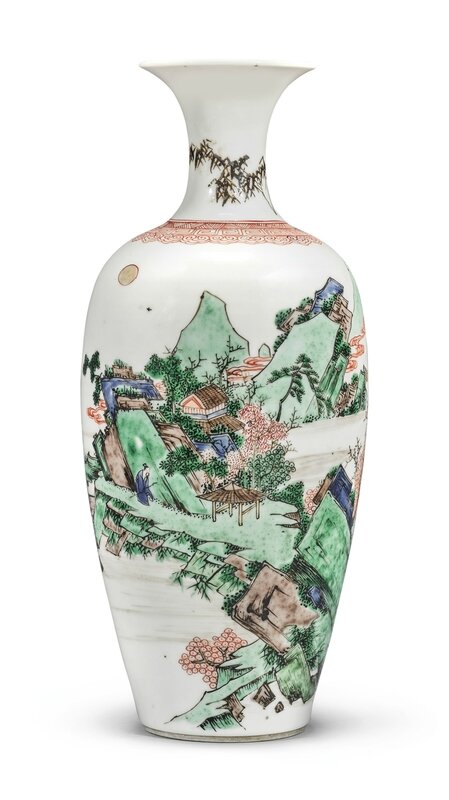Sotheby's. KANGXI: The Jie Rui Tang Collection, New York, 20 March 2018, 11:00 AM
A famille-verte 'Landscape' vase, Qing dynasty, Kangxi period (1662-1722)
Lot 305. A famille-verte 'Landscape' vase, Qing dynasty, Kangxi period (1662-1722). Height 9 7/8 in., 24.6 cm. Estimate 25,000 — 35,000. Lot sold 68,750 USD. © Sotheby's
of slender ovoid form surmounted by a trumpet neck with flared rim, painted in vibrant hues with a lakeside landscape, the rocky peninsulas zigzagging into the distance punctuated with waterfront studios and reclusive scholars, birds flying in formation above, a lone fisherman pulling in his catch, the rounded shoulder with concentric bands of chevron, keyfret, and ruyi heads in iron red, and with slender black-enameled bamboo branching up the neck, coll. no. 120
The Jie Rui Tang Collection.
Provenance: Sotheby's London, 14th May 1996, lot 67.
The Chinese Porcelain Company, Ltd., New York, 1997.
Exhibited: The Art of the Qing Potter, Important Chinese Export Porcelain, The Chinese Porcelain Company, New York, 1997, cat. no. 13.
Literature: The Chinese Porcelain Company, A Dealer's Record 1985-2000, New York, 2000, p. 117.
Jeffrey P. Stamen and Cynthia Volk with Yibin Ni, A Culture Revealed, Kangxi-Era Chinese Porcelain from the Jie Rui Tang Collection, Bruges, 2017, cat. no. 48.
Note: The bold linear style of painting on the present vase is a superb example of late ‘Master of the Rocks’ style. Initially produced in underglaze blue, this later iteration in overglaze enamels retains the angularity but refrains from the pronounced linearity and the dots and stippling used to depict foliage. The style cannot be attributed to any single artist or studio but reflects the profound influence of certain late Ming dynasty painters such as Dong Qichang, Li Shida, Gu Tianchi, Yang Wencong, and Wang Jianzhang. The jagged quality of the rockwork is softened by the rounder, more delicate strokes used for the foliage and the pale washes forming water and sky. The tiny habitations convey the longing for scholarly retreat far from the pressures of dynastic change and bureaucratic demands. For more on the topic see Stephen Little, ‘Seventeenth Century Landscape Painting and the Decoration of Chinese Ceramics’, Chinese Porcelains of the Seventeenth Century, China Institute Gallery, New York, 1995, pp. 35-41.
A pair of vases of similar form, but with integral porcelain stands, in the collection of Anthony Gustav de Rothschild is illustrated in Regina Krahl, The Anthony de Rothschild Collection of Chinese Ceramics, vol. 2, London, 1996, cat. no. 151.

/https%3A%2F%2Fprofilepics.canalblog.com%2Fprofilepics%2F1%2F0%2F100183.jpg)
/https%3A%2F%2Fstorage.canalblog.com%2F03%2F02%2F119589%2F96711876_o.jpg)
/https%3A%2F%2Fstorage.canalblog.com%2F11%2F31%2F119589%2F94773502_o.jpg)
/https%3A%2F%2Fstorage.canalblog.com%2F20%2F83%2F119589%2F94772815_o.jpg)
/https%3A%2F%2Fstorage.canalblog.com%2F26%2F72%2F119589%2F75604929_o.jpg)
/https%3A%2F%2Fstorage.canalblog.com%2F59%2F60%2F119589%2F26458628_o.jpg)



/image%2F1371349%2F20240423%2Fob_af8bb4_telechargement-6.jpg)
/image%2F1371349%2F20240423%2Fob_b6c4a6_telechargement.jpg)
/image%2F1371349%2F20240416%2Fob_65a1d8_telechargement-31.jpg)
/image%2F1371349%2F20240331%2Fob_7209d9_117-1.jpg)